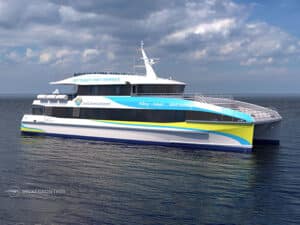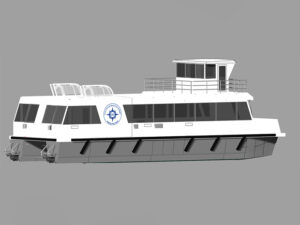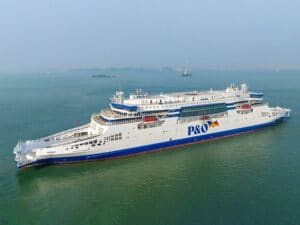
LaHood submits Marine Highways report to Congress
Written by U.S. Transportation Secretary Ray LaHood yesterday released a report that, he says, “will serve as a roadmap to the future in creating and further strengthening the nation’s marine highways”
U.S. Transportation Secretary Ray LaHood yesterday released a report that, he says, “will serve as a roadmap to the future in creating and further strengthening the nation’s marine highways”
Prepared by Marad, the report is required by Sections 1121 and 1123 of the Energy Independence and Security Act of 2007 (Energy Act). Section 1121 directs the Secretary of Transportation to establish a short sea transportation program and designate short sea transportation projects under the program to mitigate landside congestion. To meet that requirement, the Department of Transportation established the America’s Marine Highways program.
“America’s maritime transportation system is a major priority for President Obama’s administration,” said Secretary Ray LaHood, announcing the release of the report. “When we finish America’s fully-integrated, national marine highway system, our legacy will be more than routes on water. It will be a country less dependent on foreign oil. It will be a 21st century means of moving people and goods. It will be a future that America is prepared to win.”
The report highlights the Department’s accomplishments in supporting the development of America’s marine highway system. Since formally starting the program last year, Secretary LaHood designated 18 Marine Highway Corridors that will support economic growth and create jobs in communities across the country. In addition, the Department awarded $215.3 million from the TIGER I and TIGER II (Transportation Investment Generating Economic Recovery) programs to jumpstart or expand marine highway projects. Finally, the Department commissioned a study of new ship design to serve the marine highway markets and to be useful to the military if needed.
“America’s new clean energy economy will rely on a green, efficient transportation system that means making better use of our underutilized marine highways,” said Maritime Administrator David Matsuda. “This report is a valuable instrument in helping chart our course toward better energy security, reduced highway congestion and more balanced transportation networks.”
The report notes that impediments to the expansion of Marine Highway services begin with the needs such services have for specialized infrastructure and equipment. It notes the importance of reducing the costs of Marine Highway operations and administration through best practices and reducing the costs of transshipping cargoes through ports, making a case for government assistance to reduce the high acquisition costs for some types of specialized infrastructure and equipment. It also describes the importance of establishing reliable transportation services, suitable to just-in-time supply chains, as a means of overcoming shipper reluctance to try Marine Highway services. And it cites the need to educate the public and transportation planners on the important role that Marine Highway services can have for improving public welfare.
The report identifies a range of potential legislation and regulatory actions that industry stakeholders say could induce increased waterborne freight traffic on America‘s Marine Highways.
They include:
Waiver of the Harbor Maintenance Tax for some non-bulk freight
Equal Customs notification requirements for waterborne container shipments from Canada via the Great Lakes Saint Lawrence Seaway System relative to land-based shipments of the same containers
Implementation of shipper tax credits linked to the value of public benefits associated with the decision to select water transportation
Implementation of investment tax credits and accelerated depreciation for vessel and port equipment purchases
Continued Congressional appropriations for matching capital grants such as those provided through the Marine Highway Grants program and, more broadly, the Transportation Investment Generating Economic Recovery (TIGER) and TIGER II Discretionary Grants programs (some of which benefited port-related projects
Modification of MARAD’s Title XI loan guarantee program to help introduce more environmentally sustainable vessels into the U.S. fleet; and
Establishment of a Marine Highway infrastructure-oriented program similar to the Transportation Infrastructure Finance and Innovation Act (TIFIA) program that could help to fund port and terminal intermodal infrastructure.
CONCLUSIONS
Among the reports conclusions are that America’s Marine Highway must still overcome barriers before it can reach its potential. Disincentives to increased use of the Marine Highway include the unfamiliarity of shippers with this domestic transportation alternative, the lack of an established network of frequent service for container and trailer cargoes, the need for coordinated investment in port infrastructure and vessels, tax issues, and the fact that public benefits attributable to the use of Marine Highway services do not factor into many private sector transportation decisions.
The report says that the private sector will ultimately be the key to the success of America‘s Marine Highway through innovation, outreach, and investment. Private operators must demonstrate to shippers and the public that they can provide highly reliable and cost-effective transportation services by sound management and implementation of the most appropriate technologies for the safe and efficient delivery of cargoes and passengers. They must make efforts to provide greater schedule frequencies and lower the overall cost of service. They must reach out to potential customers, addressing their specific needs and concerns.
Without strong leadership from the Federal government, however,says the report, the nation’s rivers and coastal waterways will continue to be underutilized for domestic container and trailer freight transportation. It is difficult for private operators to support the scale of investment needed to initiate large scale operations. Private operators are particularly disadvantaged by the fact that many of the important public benefits of water transportation, including congestion reduction, environmental sustainability, and system resiliency, cannot be captured in the form of higher revenues or lower costs to company profits. Government action is required to help overcome these challenges and assist the expansion of Marine Highway services in a significant manner.
Download the report HERE
April 6, 2011





Leave a Reply
You must be logged in to post a comment.